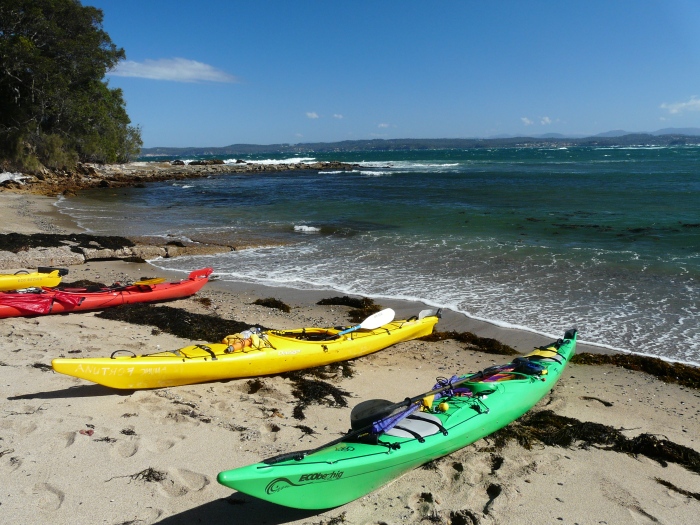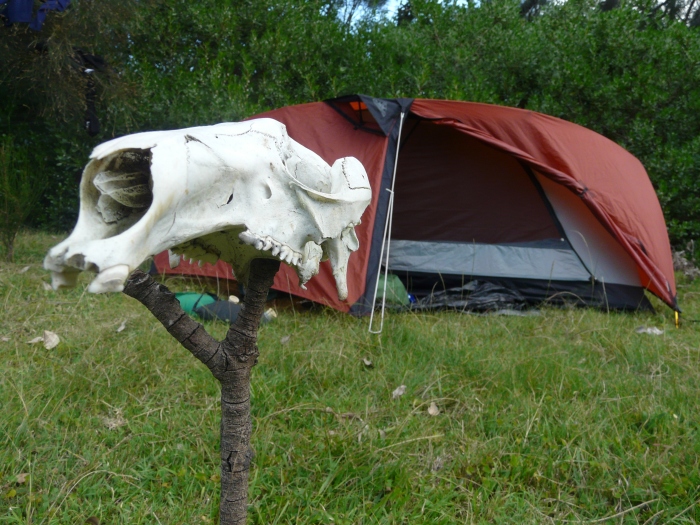At least 4,400 years ago, the Saqqaq culture of Greenland was building and using kayaks, in a way similar to the later Inuits. With these wood-and-skin vessels, they made journeys of hundreds of kilometres, capsized and rolled upright in the wake of calving icebergs and rough conditions, and hunted down seals, whales and walruses.
Their legacy lives on in the epic feats of sea kayaking performed by people like Cas and Jonesy (the Aussies who paddled the Tasman Sea to New Zealand), the insane white water playboating that we can admire at the Banff Mountain Film Festival each year, and the infamous Greenland National Kayaking Championships, where the best kayak rollers of the world manage to roll with bricks in their hands.
And then, there are people like me.
Which is not to say that people cannot enjoy kayaking without being particularly talented, for that is certainly the category of people I have fallen into (and not yet rolled out of).
As such, when the opportunity arose to learn sea kayaking skills from one of the New South Wales Sea Kayak Club’s founders, David Winkworth, I was immediately and enthusiastically fighting for a spot on the trip (I mean, this guy builds his own boats and paddles, and has wrestled a crocodile off his friend when the latter was attacked – he is a legend). The course was being run by the Australian National University Mountaineering Club, and though there was some competition for places, I managed to secure one for both weekends.
In late April we found ourselves in Congo on the NSW coast – a strange town, welcoming visitors with drooping and weathered teddy bears nailed to trees. There were rough conditions, so we spent Saturday on the estuary in wetsuits learning about rolls, braces and lean turns. Sunday was an improvement, both because the weather was marvellous and because we were full of mulled wine from the previous evening, and we spent our time surf kayaking and learning about towing.
Yes, surfing in sea kayaks. It is as likely to end with the kayaker upside down in surf as you might imagine. And yet, hurtling down a wave face (as small as ours may have been) in a barely controlled vehicle intent on turning sideways is brilliant fun.
Then, in early May, Dave took us out for the second part of the course: an overnight trip, from Bateman’s Bay to Kioloa.
Though the Saturday morning seas were placid as a milk-fed kitten, the car shuffle and gear organisation ate into the precious calm, and by the time we set off the sea was writhing most unhappily. In laden boats, with the wind and waves against us, we managed a mere 45 minutes and several kilometres in heavy swell before pulling in to a beach for lunch. The conditions were still developing, and at the very least showed no signs of subsiding, so we set up camp and spent the rest of the day there. Frisbee was played, curry was cooked, and as per usual in outdoor adventure circles: gear was discussed.
Sunday dawned as we were already breakfasting, and – determined to make up the rest of the distance in a day – we packed as quickly as we could. We set off in good conditions and spirits, though the morning took its toll. The slower paddlers, including me, fought hard to keep up with the rest of the group, which meant forgoing frequent pauses for water (for though the wind was down, the swell was still up, and the convoy consisted of the best the ANUMC had to offer). Conversely, the fittest paddlers in the group were travelling too slowly to distract themselves from the rolling swell, and the fastest was struck down by a bad case of seasickness.
For most people, the logical solution to emptying one’s stomach in a sea kayak would be over the side of the vessel. Fortunately, our fit paddler was clever enough to avoid the temptation: there are stories about people vomiting over the side, and it is a very bad idea. With their balance already minimal, and the exacerbation of feeling disoriented by looking down, people have been known to go head first into what their stomach had just expelled… and are not in the best shape to roll back up either.
In conclusion, relieving one’s seasickness directly in front and onto your spray skirt is a much better idea.
Still, we were making excellent time by averaging 7km per hour, and after 12kms of paddling we pulled into Depot Beach for lunch. There was a minimal amount of carnage in landing on the beach, in spite of the shore dump, and we were soon diving into the water and feasting on left over curry. We were still less than half way through the day’s distance, so after a brief meander in the rainforest we were back in kayaks and launching ourselves into the shore dump. There ensued slightly more carnage… but we ultimately all made it out without too much sand in our hair.
The afternoon was better, with seasickness tablets aiding some, and tows or kayak sails powering along others. I swapped paddles with a paddler in the double kayak, who had the advantage of the best paddle and easiest (since twin powered) ride, and was suddenly able to fly along. I kept level with the group, even managing to take photos with my very not-waterproof camera when it was removed from the very waterproof Peli case strapped in front of me.
The swell was still up, but I felt much better being closer to the group. Even paddling on the edge, with the open ocean on one side, was a little dizzying with the vastness of the horizon. One does not appreciate just how very tiny kayaks are, and how very engulfing the ocean is, until one is on the ocean in rolling seas. The swell in turn raises you on the crest above the rest of your brightly coloured little company, and then swallows all sight of them when it plunges you into a trough.
Finally, we rounded another headland, and were pulling into Kioloa. The last challenge of the day was paddling in with the enormous swell breaking on the rocks on the headland side of us; it was a somewhat intimidating sight of rearing waves and violently churned foam.
Still, we had conquered 25kms in a day, and had thoroughly enjoyed our first – for many of us – overnight sea kayaking experience. We might not have lived up to the Saqqaqs or even the modern Inuits, and we might have even managed to tow an entire superfluous sea kayak from the Australian Capital Territory to the New South Wales coast and back (how is that even possible?), but some of us had been challenged, we had all been safe, and all of us had a beautiful sunset… while we waited for our trip leader to find the trailer lock that he almost lost.
(For the archaeology and explanation of early kayak construction, see Matthew Walls’ excellent 2010 journal article: Paleocarpentry in the Eastern Arctic: an Inferential Exploration of Saqqaq Kayak Construction. vav.library.utoronto.ca/index.php/vav/article/download/12342/11070)








Well done Jessica. Very interesting!
Thanks Mum 😀
Lovely photos! I demand more! P.S. Guess who might be spending a month in Tassie during June-July working with Tasmanian devils? Me! Hopefully! I’m keeping my fingers crossed that it all works out and I can go, because it sounds AMAZING.
Tassie Devils, eeeee!
I look forward to visiting you there!
Pingback: Kayaking in Kangaroo Valley | words and wilds
Pingback: White Water Safety and the Murrumbidgee. | words and wilds
Pingback: Cat Ba: Exploring Ha Long Bay without a cruiseship | words and wilds